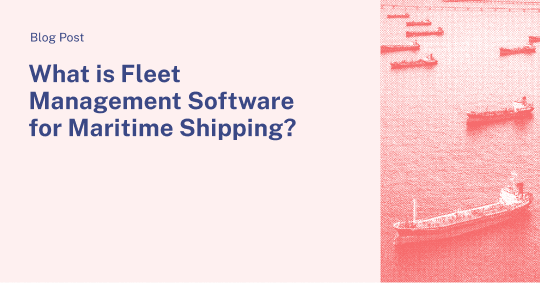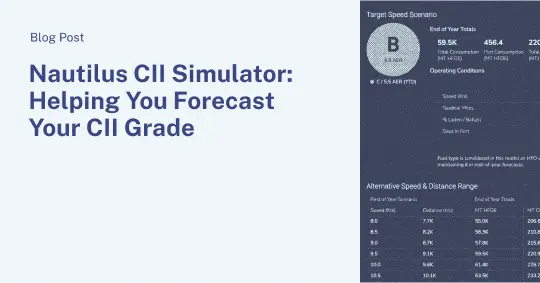Emissions regulations necessitate urgent decarbonization measures
As of January 2023, the International Maritime Organization’s (IMO’s) carbon intensity rating systems entered into force, mandating that ships measure their Energy Efficiency Existing Ship Index (EEXI) and Carbon Intensity Indicator (CII) scores to stay within acceptable thresholds. These measures aim to quantify the environmental impact of shipping and reduce greenhouse gas (GHG) emissions to drive maritime decarbonization, similar to the emissions reduction targets set in international forums such as the MEPC 80. This article will focus on the CII, explaining what it is, how to calculate it, and how to achieve good CII scores.
What is the carbon intensity indicator for ships?
CII is a measure of the operational carbon efficiency of a vessel. CII enables ship owners and charterers a standardized monitoring mechanism and incentivizes them to improve the energy efficiency of their vessels, ultimately leading to lower emissions and reduced environmental impact.
CII is derived based on the Annual Efficiency Ratio (AER), which is a carbon intensity metric that represents a ship’s carbon emissions per actual capacity-distance (deadweight tonnage per nautical mile sailed). The CII rating system provides ships with an annual rating ranging from A to E, with A being the most efficient and E the least efficient. These thresholds depend on the AER and will become increasingly stringent towards 2030. CII applies to an IMO defined class of vessel types: bulk carriers, gas carriers, tankers, container ships, general cargo ships, refrigerated cargo carriers, combination carriers, LNG carriers, vehicle carriers, Ro-Ro cargo vessels, Ro-Ro passenger vessels and cruise ships.
If a ship receives a D rating for three consecutive years or an E rating in one year, a corrective action plan needs to be developed as part of the Ship Energy Efficiency Management Plan (SEEMP), demonstrating how the required annual operational CII score of C or above will be achieved. The IMO has also urged administrative bodies and port authorities to “provide incentives” to vessels that receive A or B grades.
How do you measure your carbon intensity indicator score?
A vessel’s CII grade for the year is calculated based on reported IMO DCS (Data Collection System) data, which requires ships to provide detailed information on their fuel consumption and other relevant data. CII is determined by the quotient of the CO2 emitted and its tonnage multiplied by the distance traveled in nautical miles.
To ensure a more accurate assessment of a ship’s CII, there are adjustments and exclusions in place. For instance, certain voyages, such as those with safety issues, may be excluded from the calculation. These are known as “correction factors”, which will allow the omission or adjustments of certain periods.
The CII score is determined using the AER, which takes into account various factors affecting a ship’s efficiency. The components of the AER formula include:
- Annual Fuel Consumption: This factor considers the total amount of fuel consumed by the ship over a year.
- CO2 Emission Factor: The CO2 emission factor, calculated based on the type of fuel used, relates to the amount of CO2 emitted per unit of fuel burned. Ships using cleaner fuels or employing more energy-efficient technologies will have lower CO2 emission factors and, therefore, a better CII rating.
- Annual Distance Sailed: The distance a ship travels over the course of a year is also factored into the CII calculation.
- Design Deadweight of the Vessel: The design deadweight reflects the maximum weight a ship can carry including cargo, crew, fuel, and more. Ships with a higher deadweight capacity may achieve better CII scores if they carry a larger load efficiently. This requires gross tonnage for Ro-Ros.
AER = (Annual Fuel Consumption x CO2 Emission Factor) / (Annual Distance Sailed x Design Tonnage of the Vessel)
CII = AER (adjusted for correction factors)
Several tools and technologies are available to help ship owners and charterers measure and track their CII scores effectively. Implementing an advanced performance management platform, like Nautilus Labs’ Fleet Essentials, can provide real-time insights into a ship’s efficiency and current CII score, identify areas for improvement, and ultimately lead to better CII ratings.
What does the carbon intensity indicator mean for ship owners?
For ship owners, CII presents both challenges and opportunities. Compliance with CII regulations and reporting requirements is essential to avoid the need for corrective action and maintaining the ability to operate in international waters. As the CII rating thresholds become stricter, it is crucial for ship owners to continually improve their vessels’ energy efficiency to remain competitive in the market and command strong charter rates for their ships.
Additionally, achieving lower CII scores can lead to various incentives and benefits. Some ports may offer reduced port fees for vessels with better CII ratings, and charterers may favor contracts with more environmentally friendly ships. As the industry and consumers become more conscious of environmental issues, a better CII score can enhance a ship owner’s reputation and attract environmentally responsible clients. Additionally, ships that are more energy efficient will be more valuable to potential charterers and can command higher charter rates.
What does the carbon intensity indicator mean for charterers?
Incorporating CII ratings into chartering decisions allows charterers to prioritize friendly vessels, thereby providing additional commercial incentive for encouraging ship owners to improve their energy efficiency.
However, through their daily operational decisions, charterers play a significant role in influencing the CII scores of the vessels they charter. Collaborative efforts between charterers and owners are a prerequisite for emissions reduction (learn more about this in our blog post on How to Achieve Good CII Scores through Owner-Charterer Collaboration). With owners now accountable for CII non-compliance, we can expect to see more charter parties include clauses (like BIMCO’s CII clause for time charter parties) that oblige the charterer to redeliver the vessel at a predefined CII rating.
As awareness of environmental responsibility and ESG increases, charterers may also face rising expectations to be accountable for the Scope 3 emissions associated with their chartered vessels.
What actions can the shipping industry take to reduce greenhouse gas emissions?
With growing pressure on marine shipping to decarbonize, here are a few solutions that stakeholders can adopt to accelerate their emissions reductions efforts while maintaining profitability.
- Operational and technical optimization: With machine learning and Digital Twins, it is now easier than ever for owners and charterers to conduct data-driven fleet-wide performance monitoring, reporting, and alerting across all metrics including CII. With Nautilus Labs’ Fleet Essentials, stakeholders can stay ahead of any performance degradation or suboptimal configuration, and meet CII and decarbonization goals while successfully driving digital transformation across their organizations.
- Collaborative charter parties: Legacy commercial structures between owners and charterers impede collaboration between the two and create a lose-lose system centered around financial penalties. With Green Charter, stakeholders can leverage modern technology to update traditional charter parties, improving commercial outcomes for owners and charterers and cutting excess ship emissions and fuel consumption.
- Just-in-time or virtual arrivals: As we explored in a whitepaper co-written with BIMCO, the shipping industry’s inefficient operating patterns needs to change, starting with eliminating “hurry-up-to-wait” (or “sail fast, then wait”) behavior in favor of optimized port arrivals. While decarbonization solutions like alternative fuels or renewables may still be in development, with already existing machine learning technology, there are few technical barriers to calculating the optimal speed for a vessel to sail at in order to arrive when a berth is available – however, we need to restructure the commercial incentives in our industry to make these changes possible.
Embracing a decarbonized future
The Carbon Intensity Indicator (CII) is a pivotal tool in the maritime industry’s journey toward decarbonization and environmental sustainability. By quantifying and rating the energy efficiency of ships, the CII encourages ship owners and charterers to adopt more environmentally friendly practices, reduce GHG emissions, and align with global emission reduction goals.
For sustainability managers at ship owners and charterers, the CII presents an opportunity to take the lead in the industry’s efforts to combat climate change. Embracing the CII and actively working towards improving the energy efficiency of fleets can result in a more competitive position in the market, reduced operating costs, and a positive impact on the environment. As conversations and searches on CII continue to grow, platforms like Nautilus Labs provide essential support, insights, and technology to navigate the path to a more sustainable and prosperous future for the maritime sector.
If you would like to discuss pathways to decarbonization and improving your CII rating, reach out to us.


